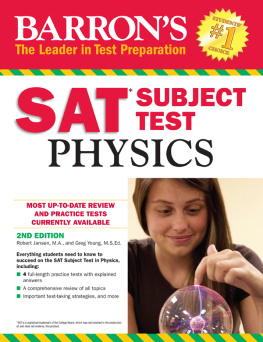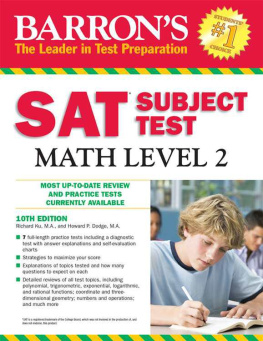
About the Authors
Robert Jansen teaches Advanced Placement Physics at Aliso Niguel High School in Aliso Viejo, California. He has taught Advanced Placement Physics B since 1998 and the complete Advanced Placement Physics C course, including electricity and magnetism, since 2001. He holds a bachelors degree in psychobiology from the University of California, Los Angeles and a masters degree in education from Pepperdine University. He gravitated toward teaching physics due to the challenging material and a sustained belief that physics does not need to be mysterious and difficult, but rather comprehensible and achievable. The result has been a large and competitive physics program where each year over 220 students participate in the AP Physics B and C courses. The overarching goal is preparedness and confidence for students who will be studying science during their undergraduate years.
Greg Young has been teaching high school science for more than twenty years. He currently teaches Honors Physics and Chemistry at San Clemente High School in San Clemente, California. He holds a bachelors degree in biochemistry from the University of California, San Diego and a masters degree in science education from USC. Having always been interested in science and how to make it relevant to others, Gregs interest in teaching is being able to create interactive lessons that engage students in their learning and form a relevant context for difficult concepts in physics and chemistry. Science made interesting is science worth learning.
Copyright 2016, 2013 by Barrons Educational Series, Inc.
All rights reserved.
No part of this publication may be reproduced or distributed in any form or
by any means without the written permission of the copyright owner.
All inquiries should be addressed to:
Barrons Educational Series, Inc.
250 Wireless Boulevard
Hauppauge, New York 11788
www.barronseduc.com
eISBN: 978-1-4380-6856-5
Revised e-Book publication: September 2016
Welcome to Barron's SAT Physics, 2nd Edition e-Book version.
Please note that since this is an e-Book illustrations, graphs, charts, tables, and equations may appear differently depending on which device you are using. Please adjust your settings accordingly.
This e-Book also contains hundreds of hyperlinks that will help you navigate through the content, bring you to helpful resources, and allow you to click between all questions and answers.
Good luck on your SAT Physics exam!

T he SAT Subject Test in Physics is designed to assess the outcome of completing a college-preparatory physics course in high school. Although state and course requirements for physics may vary, all college-preparatory physics courses should address certain core topics and principles. The SAT Subject Test in Physics focuses on this common ground. The goal of this book is to review the main topics and concepts that are likely to appear on the SAT Subject Test in Physics and help you prepare for the exam.
The chapters are organized to maximize the effectiveness of your study time. Each chapter begins with a summary of the topics to be covered, bulleted points of the major topics, and a list of new variables discussed in the chapter. The body of the chapter includes a discussion of the topics along with relevant example questions. Each chapter also includes a unique Whats the Trick? approach to help you solve the questions quickly and effectively. The margins contain tips called If You See... which point out some of the major insights into critical topics and difficult concepts. The end of the chapter contains a bulleted summary along with a table grouping the critical If You See... elements as a concentrated review. Each chapter is followed by multiple-choice practice questions with answers and explanations.
QR codes appear throughout the text, next to key examples. Each QR code links to an online video explanation of the example problem it is associated with. The following QR code is linked to the table of contents for all of the videos available for this text. The available video sequences solve selected example problems in a dynamic manner.
In addition to the chapters that review the exam content, the book includes four complete practice exams. The first practice exam should be used as a diagnostic test to assess your current level of understanding of the subject matter and to establish a baseline score to improve upon. Ideally, you should take this first diagnostic examination using the same guidelines as an actual SAT Subject Test in Physics:
Time limit of 1 hour for 75 multiple-choice questions.
NO calculators allowed.
No physics formula sheet is allowed, and none will be provided.
Correct answers receive 1 point.
Subtract point for each incorrect answer.
Answers left blank receive 0 points.
Table of Contents for Video Example Problems
(Tap or click the below)

A complete list of test-taking parameters and how to find your approximate raw score is provided near the end of this introduction. You should take the other three examinations after you have completed all or portions of your review.
Different students will approach this review in a variety of ways. Some may choose to work methodically through each chapter, which will require starting well before the actual exam date and setting aside adequate review time. Students with limited time may decide to read the important If You See... tips in the margins and attempt the end-of-chapter questions to determine if they should study a particular chapter in depth. Keep in mind that each chapter builds on the material from previous chapters. Skimming the material too quickly, especially in chapters containing key foundational material, can result in errors throughout the entire exam. Remember these helpful tips as you use this review book:
Start reviewing the material well before the exam date. Set aside an hour or two each day to read through the chapters. Trying to cram in all the information at once is not as effective as reviewing smaller portions over time.
Solve the practice problems as though they are an actual exam. Merely reading the solutions without actually attempting to solve the problems will not help you to understand the material.
Being able to visualize the events described in an exam question is a valuable skill in physics. Students who construct diagrams to represent the situations described in physics problems tend to earn better scores on the exam.
Some questions require you to recall facts, and others require you to understand concepts and principles. Many involve the use or understanding of formulas without complicated arithmetical calculations. Calculators are not allowed on the examination, and a list of formulas is not provided. Therefore, memorizing key physics formulas and having a working knowledge of how to manipulate variables are crucial for success.
A complete outline of the contents of the SAT Subject Test in Physics can be obtained from the College Boards website at http://sat.collegeboard.org . The College Board, which writes and administers the examination, does not publish copies of former examinations. However, they do offer sample questions on their website.
All questions are multiple-choice and have five answer choices. The practice tests and sample questions in this book reflect both the content and the question formats found on the SAT Subject Test in Physics. The exam tests students knowledge in 6 topics.
Next page






